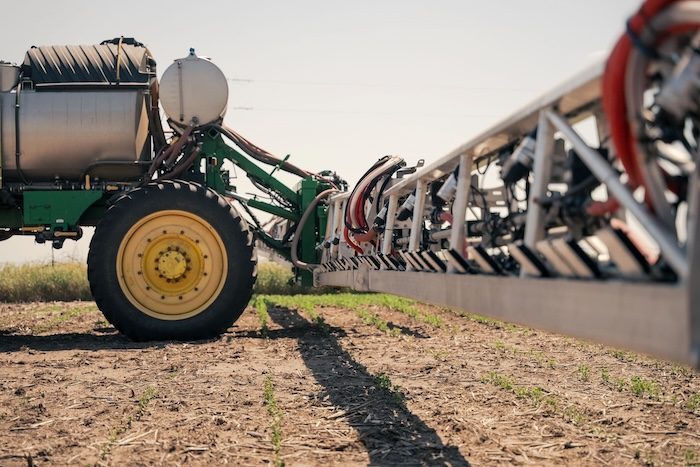Nestled in the heart of the Texas Panhandle near White Deer, Pohnert Farms spans approximately 8,000 acres. Owned and managed by Dudley Pohnert and his family, it’s one of the last remaining family-operated farms in the region.
Pohnert Farms’ crop rotation includes cotton, corn, milo, and wheat. Dudley and his family take a hands-on approach to all aspects of the farm’s operation, from planning and planting to weed management, ensuring the land thrives as a testament to their hard work and dedication.
However, farming in the Texas Panhandle is not without its challenges. The region is known for its intense summer heat, persistent spring winds, and narrow operational windows for spraying — all factors that complicate weed control. These challenges are particularly evident in cotton farming, which requires meticulous management to secure a successful harvest.
Tackling Herbicide Resistance
Cotton farming poses distinct challenges when it comes to weed control. The crop's long growing season encourages multiple weed flushes, necessitating more post-emergence herbicide applications than other crops, which significantly increases input costs for farmers. Furthermore, the typical 30–40-inch row spacing in cotton fields not only allows more sunlight through but also provides abundant nutrients, creating an ideal environment for weeds to thrive and compete with the crop.
These challenges are compounded by the weather conditions in Texas, where the strong spring winds as well as frequent dust storms hinder herbicide application. Timing becomes critical in this environment, as weeds must be sprayed when they are just 2-4 inches tall. If missed, they can quickly grow beyond control, making effective management nearly impossible.
In recent years, herbicide resistance has exacerbated the challenges cotton farmers face. As resistant weed strains continue to spread, traditional herbicides are becoming less effective. This creates additional economic and operational pressures for farmers, making it even more difficult for them to control weeds during the critical early stages of growth.
“Tackling herbicide resistance is a major challenge across all crops, but it’s especially tough with cotton,” Dudley says. “We use the most effective tank mixes available, but they’re still not providing the results we need. In reality, we should be spraying our fields twice as often as we do, but the high cost of chemicals makes that unfeasible.”
To keep one step ahead of the weeds, Dudley’s workdays often begin before dawn, with his sprayer running under lights to avoid the high winds and heat of the afternoon. Despite his best efforts, managing weeds, weather, and economics has become an increasingly demanding challenge.
Smarter Weed Control
Things began to change for Dudley when he discovered Greeneye Technology at a trade show. While he was aware of advancements in precision spraying technology, he had been reluctant to make an investment due to the limited options available. Specifically, he was deterred by "factory fit" solutions that would require purchasing an entirely new sprayer, a precision spraying system, and committing to ongoing subscription fees. Greeneye, however, stood out by offering a retrofit solution that allowed him to upgrade his existing John Deere sprayer without the burden of recurring costs.
The system's proven track record was another compelling factor. Widely used by corn and soybean farmers in the Midwest, the Greeneye system is proven to reduce non-residual herbicide use by 87% on average compared to broadcast application. With the system’s capabilities recently expanded to include cotton, it became even more relevant to Dudley’s operation.
Combining cutting-edge hardware and proprietary AI technology, the Greeneye system identifies crops and weeds in real time with sub-millimetre precision, ensuring herbicide is applied only where it’s needed — directly on the weeds. This targeted approach not only minimizes herbicide us but also delivers the same, if not better, efficacy as traditional broadcast spraying.
There were other features that resonated with Dudley as well. The Greeneye system’s hardware includes proprietary high-intensity lighting, allowing him to spray around the clock and overcome weather-related challenges such as dust, wind, and heat. Additionally, the system is effective for both pre- and post-emergence applications, and its dual-line configuration enables simultaneous precision and broadcast spraying, greatly enhancing operator efficiency.
Many farmers choose to reinvest some of the cost savings they achieve using the Greeneye system into more powerful tank mixes. For Dudley, however, the real benefit lies elsewhere. Already using the strongest herbicides available on his cotton fields, the reduced spraying costs will enable him to apply treatments more frequently giving him a crucial advantage in the ongoing battle against weeds and herbicide resistance.
“The Greeneye system will allow us to significantly increase the frequency of spraying, both pre- and post-emergence, yet at the same time, we anticipate it will reduce our annual herbicide use by between 25 and 40%, achieving payback in just two to three seasons,” Dudley says. “Beyond that, we expect healthier crops, fewer weed escapes, and, ultimately, better yields.”
More Sustainable & Profitable Future
For Dudley, the benefits of adopting the Greeneye system extend far beyond chemical reduction and cost savings — it’s about laying the groundwork for better sustainability and smarter resource use on his farm. With herbicide treatments evolving slowly, precision spraying presents an immediate and powerful opportunity to maximize the effectiveness of existing options and tackle weed resistance head-on. Looking ahead, he also envisions using the Greeneye system for more than just weed control.
“This technology could also revolutionize other aspects of our operations,” Dudley says. “We’re already looking at how it could be used to apply inputs such as fungicides and micronutrients. And there’s also potential for stem counting and advanced crop health monitoring.
“This is bigger than just saving on herbicide costs,” he adds. “We’re setting up our farm to be more sustainable and resilient for the future. The sky really is the limit for what the Greeneye can do for us.”



![[Technology Corner] Discussing AI’s Potential Impact on Service & Support](https://www.precisionfarmingdealer.com/ext/resources/2025/04/11/Discussing-AIs-Potential-Impact-on-Service--Support.png?height=290&t=1744385717&width=400)


